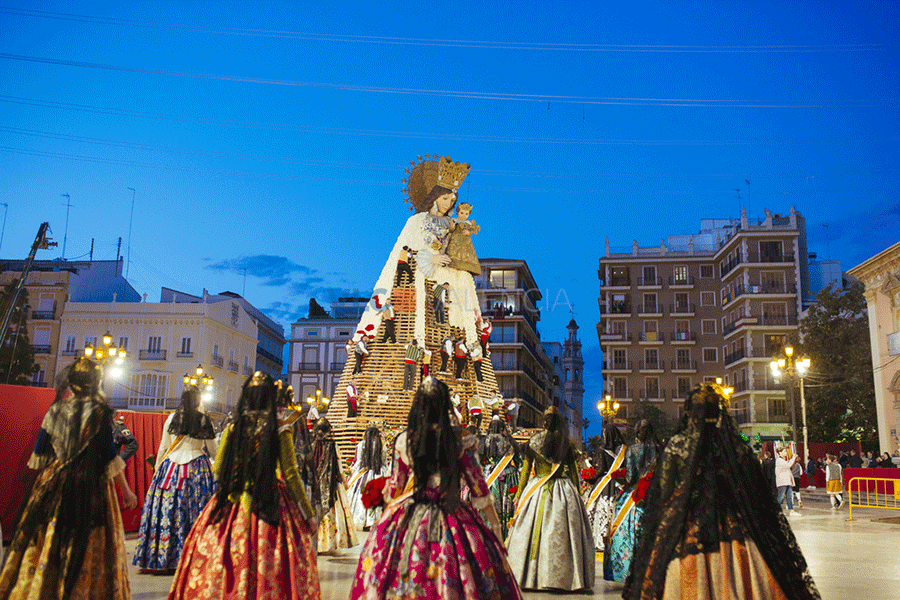The great Valencian festival, declared an UNESCO Intangible Cultural Heritage event in 2016, returns this year in all its splendor.
VALENCIA, Spain (March 10, 2022) – After a two-year hiatus, one of Spain’s most beloved festivals returns to the streets of València this month. Celebrations begin with the‘Crida’ – the opening ceremony where ‘Mayor of Falleras’ encourages citizens and visitors to enjoy the festival. Declared an event of Intangible Cultural Heritage by UNESCO in 2016, Las Fallas has returned with traditional acts such as the mascleates (fireworks), late night parties, and art installations where around 800 monuments fill the streets with color, humor and joy. Every day of the festival is a party, but to experience Las Fallas at its best, visit from March 15 to March 19.
The origin of Las Fallas
Hundreds of years ago, València’s carpenters would burn old remains from their workshops every March 19, coinciding with the celebrations of San José, the patron saint of carpenters. This marked the end of winter and gave a warm welcome to spring.
While the festival has changed over the years, Las Fallas has maintained its heritage and traditions. Every March 15, giant sculptures – which range from large satirical pieces to small representations of everyday scenes – are set aflame in large bonfires. While burning, these authentic pieces of art, created by the guild of Fallas artists, are usually accompanied by musicians, pyrotechnics, costumes and florists.
Fallas 2022 – More alive than ever
Like many of the world’s great festivals, Las Fallas was affected by the pandemic and now plans to rise from the ashes and shine again in the streets of València. This year, Covid safety measures, such as wearing masks, will continue in all indoor activities and outdoor events where social distancing cannot be guaranteed. Discover the complete program of events here.
Gunpowder, music and art
One of the most spectacular acts of Las Fallas is the mascletà – Valèncian-style fireworks – which occurs at 2 p.m. every day until March 19 with a roar of gunpowder. In the evening, guests can visit the Turia Gardens for fireworks at the castle.
On the nights of March 15-16, València begins the planta, the erection of monuments in the streets where 800 works of art are spread across 400 locations in the city. Thesefallas are classified into different categories according to their complexity, size and originality. The most spectacular are placed in the historic center – Ciutat Vella – and the neighborhoods of Ruzafa and Gran Vía. The best way to appreciate the monuments is with a guided tour where a knowledgeable local can highlight the most spectacular sculptures and tell visitors the details and traditions of the festival.
The festival continues with an awards ceremony in which the Fallas artists collect prizes for their masterpieces, as well la ofrenda – the offering – in which the city offers flowers to the Virgen de los Desamparados, the patron saint of València. Festival-goers dress in traditional attire and walk the streets to the beat of local musicians whilst carrying bouquets. The procession ends at the Plaza de la Virgen, where a giant image of the Patron Saint is installed and covered with flowers.
La Cremà – the end and beginning of the festival
With the ‘Cremà’ comes the final act of the Fallas. On Saturday, March 19, the sculptures are set aflame in great bonfires that cover the city. The process is carried out in a staggered way, starting at 8 p.m. with smaller statues and 11 p.m. with the larger ones and the winners.
With the bonfires come the finale fireworks, which signal the end of Las Fallas. The old remains are burned away, and the city looks toward the future in a magical ceremony of spring and renewal. Las Fallas is a spectacle that truly is a once and a lifetime experience.
For more information on Valencia, please go to www.visitvalencia.com/en.
About Visit Valencia
Renowned for its mouthwatering gastronomy and home to the Spanish dish paella, Valencia is a must-see destination when discovering Spain. Located on the Iberian Peninsula with immediate access to the Mediterranean Sea, travelers who visit Valencia can experience 75 miles of beaches, including the famous La Malvarrosa, year-round warm weather, and plenty of outdoor activities such as bike routes that span nearly 100 miles and hike trails that cross the Albufera National Park. Featuring three UNESCO World Heritage Sites, impressive museums and spectacular gardens, this vibrant city is filled with breathtaking sights including the Palace of the Marquis of Dos Aguas, the historical Old Town, and charming neighborhoods that reflect Valencia’s past and present culture. Designated the World Design Capital for 2022, those who vacation in Valencia must explore the City of Arts and Sciences and revel in its innovative and futuristic buildings. Visitors can choose from all sorts of accommodations ranging from beachfront lodging to luxury historical palaces. A port city ideal for the eco-conscious traveler, it is the first destination to be awarded by AENOR for verifying the carbon footprint of its tourist activity, and the Richard Camarena Restaurant, located in the heart of Valencia, was rewarded a Green Michelin star for its constant commitment to the environment. To learn more about the Spanish city of Valencia and begin to plan your trip, visit: www.visitvalencia.com.



